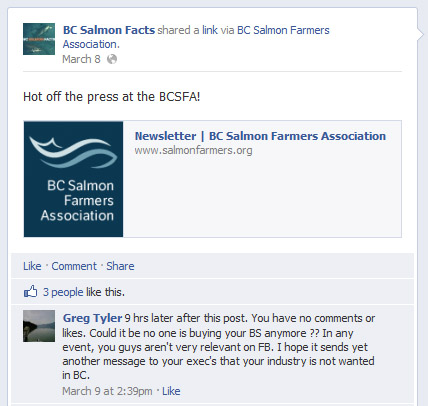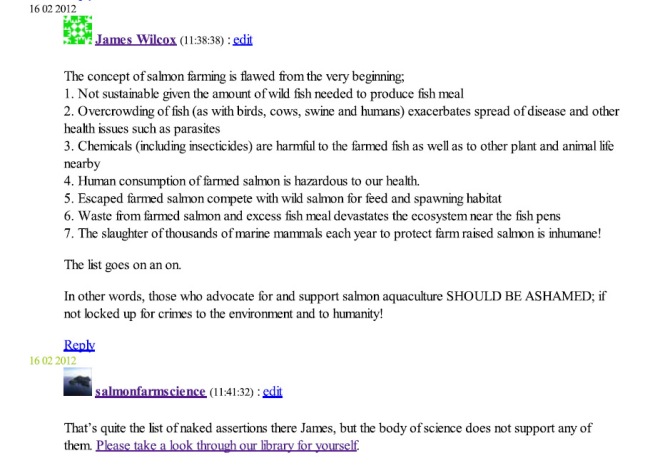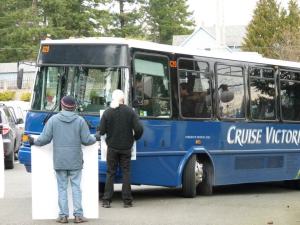Closed containment fish farming is considered by anti-fish farm activists to be the panacea to all aquaculture problems.
However, problems such as land use, energy use, water use and waste removal are mostly ignored because the idea of separating farmed fish from wild sounds so easy without all the messy details.
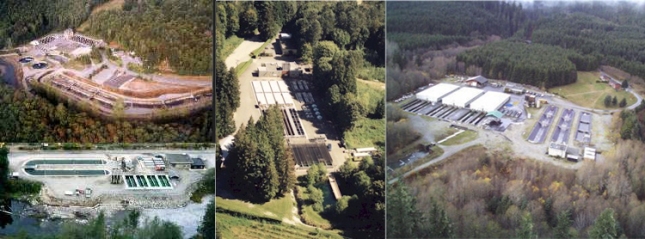
Even wild fish hatcheries have an impact through land use, energy use and fish feed.
In September 2010 DFO did a financial analysis of 10 closed containment technologies. (emphasis added)
Closed-containment includes a range of technologies and operating environments, from ocean- to land-based production systems, with varying degrees of isolation and environmental interaction. Typically, the more closed a system is, the more complex it becomes, since its energy requirements are often greater and waste can be more of an issue.
… This analysis is a two-step process, involving 1) an overview of existing and developing technologies, along with a complete evaluation of the technical aspects and external risks of the most promising technologies; and 2) a financial assessment of the most promising technologies identified in the first stage.
The findings of this paper showed that closed containment is not an economically viable option for raising salmon to market size.
Closed containment salmon farming unlikely to be viable
Canada: A new report from the Canadian government suggests that only a full recirculation system on land could be the only type of closed containment that could have a hope of making a small return on investment
The new DFO report focused on a more detailed financial evaluation of the various systems, and “To begin the study, DFO conducted a preliminary financial assessment of all technology types identified by CSAS. The results indicated that only two of them—net pen and recirculating aquaculture systems (RAS)—were likely to show positive returns”. The RAS system showed a marginal return after three years of operation of 4% on an investment of some CAD$ 22.6 million- even after being given a favourable and perhaps unrealistic Biological Feed Conversion Rate (FCR) of 1.05 and twice the density of a typical net pen farm. In comparison, a conventional net pen operation with an initial investment of CAD 5 million would show a return of 52%, with a FCR of 1.27.
Anti-net pen aquaculture groups who rally behind the idea that closed containment is the only answer saw the report in a different light.
DFO study affirms viability of closed containment technology for salmon aquaculture
The Feasibility Study of Closed-Containment Options for the British Columbia Aquaculture Industry recognizes that land-based recirculation aquaculture systems (RAS) are likely to show positive returns and that once the technology becomes more widely adopted within the sector, capital and operating costs may continue to go down.
“This new study shows that closed containment salmon farming is economically viable, something we have said for years,” says David Lane of T. Buck Suzuki Environmental Foundation and CAAR. “In fact, numerous companies are moving ahead with plans for closed containment in B.C., creating a potential multi-million dollar sustainable salmon farming industry, with new jobs and an economic boost for coastal communities.”
This is a very optimistic reading of the DFO report. If this idea were brought to the dragons den with only a 4% return after three years it would be immediately turned down by all the panelists.
Closed containment is already used by all the salmon aquaculture companies to raise their eggs to the size needed before placing them in net-pen to grow to market size. RAS technology is currently being used at their hatcheries and further research into this technology is important to these companies.
 Marine Harvest Canada had a need to enhance the management of its hatcheries and turned to the innovative use of the recirculating aquaculture system (RAS) where freshwater is filtered and reused. Today Marine Harvest operates nine RAS systems in its British Columbia hatcheries thereby enhancing the growth and health of young fish and reducing water requirements by 90%-97%.
Marine Harvest Canada had a need to enhance the management of its hatcheries and turned to the innovative use of the recirculating aquaculture system (RAS) where freshwater is filtered and reused. Today Marine Harvest operates nine RAS systems in its British Columbia hatcheries thereby enhancing the growth and health of young fish and reducing water requirements by 90%-97%.
The success of its RAS hatcheries has led Marine Harvest to consider the possibility of growing fish to market using land-based RAS. If this technological innovation proves viable technically and economically its use may address environmental and fish husbandry challenges that are of concern to the company and to society – but it may introduce additional challenges. At present it’s not at all clear that RAS closed containment is a viable option, but the company wants to find out.
Mainstream Canada’s parent company Cermaq is also interested in the development of these technologies.
CERMAQ´S POSITION
• Cermaq believes that present technologies for open net pens allow for sustainable aquaculture, and we aim to demonstrate this in our operations.
• Closed-containment technology does not currently represent a viable alternative, due in particular to its higher energy consumption and remaining risk of escapes.
• Cermaq will be following the development of closed containment aquaculture, and will consider testing of new concepts and explore the possibilities of closed-containment fish farming if suitable projects are presented.
The energy cost in a closed system will be significantly higher compared to the free energy given by the hydrodynamic forces in the sea. Although closed-containment systems are currently being described and promoted as environmentally-friendly alternatives to net-pen farming, there is an environmental cost associated with employing this technology which should be considered in any further evaluation of their environmental performance.
OUR INITIATIVES & ACHIEVEMENTS
• Cermaq is demonstrating that net-based salmon aquaculture is a highly sustainable way to produce salmon.
• Cermaq does not develop technology or technical equipment for fish farming, but is following technology developments closely, including the development of closed containment aquaculture.
• EWOS Innovation is testing closed containment equipment to build knowledge and network on such technologies.
These companies have invested a lot in their hatcheries and they know a lot about closed containment technologies. Salmon aquaculture companies are very interested in closed containment technology improvements, but they are realistic about the fact that, right now, closed containment is not the best choice for the entire life cycle of the fish.
Some small groups have built land based and ocean based closed containment facilities but they are proving to not be very profitable.
Farming salmon on land is a risky proposition only suitable for niche markets
Land-based salmon farming workshop brings farmers together
Campbell River Mirror, September 29, 2011 2:00 PM
Thue Holm, the CEO of Atlantic Sapphire AS, is currently working on developing a facility in Denmark capable of farming 1,000 metric tonnes of salmon on land. However, he offered some words of caution.
“It’s a niche product,” he said, pointing out that a small-scale facility such as his can’t compete directly with the main farmed salmon market.
Finding a specialized market for his product, as well as selling it at premium pricing, is important, he said.
Location is also crucial, said Steven Summerfelt, director of aquaculture systems research for the Freshwater Institute in West Virginia. Summerfelt spoke at the workshop about several projects he is involved with, including a planned land farm site in Washington State which can buy electricity for only two or three cents per kilowatt-hour (BC Hydro’s business rates are closer to 9 cents per kilowatt-hour).
Summerfelt said farming Atlantic salmon on land has potential “if you can pick sites with cheap power right next to the market.”
In order for land-based salmon farms to be profitable, he said, they have to farm fish at much higher densities than ocean net pens. Conventional net pen systems farm fish at a density of about 15 kilograms of fish per cubic metre at their peak size. In order for a land-based farm to be profitable, it would have to farm fish at densities close to 80 kilograms per cubic metre or even higher, he said.
There are other closed-containment pioneers.
Closed-containment fish farming initiative launched
Glen Korstrom, Business in Vancouver, February 15, 2011
 Swift Aquaculture co-owner Bruce Swift farms a small amount of salmon in land-based closed-containment tanks in Agassiz and sells most of those fish to restaurants such as C, Nu and the Raincity Grill.
Swift Aquaculture co-owner Bruce Swift farms a small amount of salmon in land-based closed-containment tanks in Agassiz and sells most of those fish to restaurants such as C, Nu and the Raincity Grill.
He supplements fish-farming revenue by growing wasabi, watercress and other crops, which are fertilized with fish farm waste.
Swift’s production is small, however. Overwaitea Food Group therefore sources supplies of closed-containment salmon from Washington state-based SweetSpring.
But SweetSpring owner Per Heggelund earns less than half of his revenue from selling fish to Overwaitea.
The balance is generated by providing training programs for saving endangered fish species in the U.S. and selling fish eggs.
This article also refers to the in-ocean floating solid-wall pen system near Campbell River.
Walker added that, more than simply being a sustainable option, farming salmon in closed tanks in the water instead of open-net pens is also good business.
“It makes sense to control your rearing environment. There’s an old saying, ‘You can’t manage what you can’t control.’”
Walker added that algae blooms wipe out millions of fish each year. But water for AgriMarine’s fibreglass and metal tanks is drawn from depths that reduce the likelihood of such blooms.
“We control the internal rearing environment so we supplement with oxygen as well so if there’s low dissolved oxygen then we don’t suffer from that,” he said.
AgriMarine lost $2.1 million in the six months that ended September 30, when it had a $14.6 million accumulated deficit.
It’s unclear how far the company is from achieving profitability. However, Walker told BIV that, unlike other companies’ past closed-containment experiments, which were done on land, AgriMarine’s water-based operation is scalable. That’s an important consideration in a sector where economies of scale often dictate profit.
“Land-based systems will be quite a bit more expensive – by orders of magnitude,” he said. “It’s a completely different technology. When a lot of people say closed containment is too expensive, they’re referring to land-based closed containment.”
But floating tanks in the ocean aren’t cheap either, and the DFO report on all the different technologies found that they would not be profitable at a large scale.
Odd Grydeland, fishfarmingXpert, November 26, 2010
The [DFO] report suggested that a system using rigid, floating ocean tanks to produce the 2,500 tonnes per cycle of Atlantic salmon would show a negative return of between -2 and -10%. This doesn’t bode well for the newly delivered tank for AgriMarine, Inc., which is installing such a system north of Campbell River these days, although they are using a larger tank and Pacific salmon.

One of the major financial backers for AgriMarine is a coalition of anti-fish farm groups. The Coastal Alliance for Aquaculture Reform has a very specific interest in closed containment projects. CAAR states on its site that it “is a coalition of four leading environmental organizations working to transition the open net-cage salmon farming industry to more sustainable production methods. The groups involved are the David Suzuki Foundation, the Georgia Strait Alliance, the Living Oceans Society , and the T. Buck Suzuki Foundation.”
CAAR threw their full support behind AgriMarine’s farm:
…We are writing to express our support for the Agrimarine Middle Bay Closed Containment salmon farm. …We believe the Middle Bay operation shows there are real, viable alternative methods to dealing with the proven environmental impacts of open net pen aquaculture and will be a valuable contribution towards demonstrating the effectiveness and economics of closed containment fish farming. …Predator interactions or kills will likely be completely avoided as will farmed salmon escapes.
Alexandra Morton supported AgriMarine but did have some reservations:
A long-time opponent of open-net fish farming has given the thumbs up to B.C.’s first-ever closed, floating salmon-farming tank.
…Morton said she only has one concern.
“I’d prefer that they were completely out of the water, because the ocean always breaks everything that’s in it eventually,” she said. “But really, my hat is off to them [AgriMarine] and all power to them. I mean, this is what needs to happen. This is the answer—closed containment. It could be a B.C. industry. Once you go into closed containment, you can grow a lot of exciting things, like algae, for example. People should really look into that—sunlight and water and you are making food.”
Even politicians were jumping on the AgriMarine bandwagon.
BC opposition party still insisting on closed containment salmon farming
Canada: New Democratic Party MLA’s heralding new farming model yet to hit the water.
With only three months until the May 12 provincial election in British Columbia, the two main political parties- The governing Liberal Party and the opposition New Democratic Party (NDP) are starting to manouvre into positions that they think can garner some votes.
…In a recent interview with Kris Schumacher of The Prince Rupert Daily News, two NDP MLA’s endorsed new technology being developed by Agrimarine Industries in Campbell River, using a set of floating, solid-wall tanks with seawater pumped in and circulated through the tank holding the fish before being discharged back to the ocean. Both Skeena MLA and fisheries critic Robin Austin and North Coast MLA Gary Coons were members of the NDP-dominated Special Committee On Sustainable Aquaculture (Austin was the Chair) that delivered a report almost two years ago, recommending that all salmon farms should be transitioned into closed containment systems.
There were some others with reservations:
Odd Grydeland
When the Canadian Department of Fisheries and Oceans wants a scientific opinion about a certain matter, it often relies on the Canadian Science Advisory Secretariat (CSAS) which coordinates the peer review of scientific issues for the Department. CSAS also coordinates the communication of the results of the scientific review and advisory processes. Four years ago, CSAS undertook an in-depth review of various forms of “closed containment” technologies that could potentially be used in the salmon aquaculture industry. Its 2008 report; “Feasibility Study of Closed-Containment Options for the British Columbia Aquaculture Industry” found- among else- that “A review of over 40 closed-containment systems from around the world found that none was producing exclusively adult Atlantic salmon and that many previous attempts to do so had failed. Reasons for failure were numerous and were often interrelated. These reasons included but were not limited to mechanical breakdown, poor fish performance, management failure, declines in market price and inadequate financing”.
With respect to the technology that AgriMarine has been promoting as environmentally superior to conventional, floating net pens was found to require almost five times the capital investment, and the CSAS report stated that; “The engineering challenges associated with various designs of floating closed-containment systems were modeled. Those constructed of rigid material and anchored to the bottom represent a particular challenge in terms of the tidal currents and wave heights that are typical of exposed areas, which may mean that site selection for those types of structures may be limited by these two oceanographic factors”. DFO conducted a preliminary financial assessment of all technology types identified by CSAS, resulting in the findings that only conventional net pen and Recirculating Aquaculture Systems (RAS) were likely to provide a return on investment, although the latter just barely.
The conditions around Vancouver Island proved to be too much for the rigid wall containment system and in March of 2012, after a severe wind storm, the tank was damaged.
2,745 farmed Pacific salmon escaped from facility of “leader in floating solid-wall containment”
Canada’s Department of Fisheries & Oceans (DFO) disclosed yesterday (April 18) that 2,745 farmed Chinook salmon (Oncorhynchus tshawytscha) escaped on March 12 from the Vancouver Island/British Columbia demonstration farm of the “leader in floating solid-wall containment technology and production for sustainable aquaculture”, AgriMarine Holdings Inc. “An extreme storm event caused damage to the containment structure at their facility in Middle Bay, allowing some fish, averaging 2.1 kg, to escape…,” DFO wrote. This regrettable incident is noteworthy because closed-containment technologies have been hailed by many salmon farming critics and eNGOs as being ‘the future’ of marine finfish aquaculture, notably because they made fish escapes supposedly impossible… In noticeable contrast, no other fish escapes were reported from other ‘conventional’ salmon farms in BC. On March 14th, AgriMarine had reported “some storm related losses”. On March 21, Robert Walker, President of AgriMarine Industries, had told SeafoodIntelligence: “… Until we completely empty the tank we won’t know the final number, but at this time it appears that we did not lose any fish.” The Toronto, OTCQX & Frankfurt stock-listed firm did not, yet, communicate on the escapes. One (including investors) would be in a position to expect the same transparency from AgriMarine as from other (listed or not) salmon farmers. And since when did AgriMarine know? The firm said itself it had filed a report with the feds on March 14. Yesterday, a top salmon farmer (Cermaq) stated in its 2011 Report that “Closed-containment technology does not currently represent a viable alternative, especially related to energy usage but also [fish] escapes remain a risk in closed containment farming.”
AgriMarine did put out a press release about the event but it leaves more questions than answers.
As previously reported by FishfarmingXpert, a couple of weeks ago AgriMarine reported that its floating, 3,000m³ tank had suffered some damage, and today it confirms that most of the Chinook salmon grown in the tank have been sent to a processing plant at about half of the projected harvest size- approximately four pounds (~1.8 Kg) dressed weight. The company plans to repair the tank and continue with the deployment of additional, re-designed tanks.
…As expected, AgriMarine is trying to put a positive spin on this catastrophic event, but some of its statements warrant some scrutiny;
- AgriMarine is pleased to report the first commercial harvest at its Canadian demonstration site at Middle Bay in Vancouver Island, British Columbia
- Comment: How can a company be pleased by having to harvest its crop at half the planned size due to the failure of its technology- advertised as superior to net pens?
- Management feels that harvest results prove the commercial value of AgriMarine’s unique technology for sustainable aquaculture
- Comment: How can AgriMarine suggest that this event proves anything regarding commercial validity without providing any cost figures?
- The fish reached a harvestable size in 13 months, thus demonstrating excellent growth rates achievable in the AgriMarine System
- Comment: How do these growth rates compare with Chinook salmon grown in traditional net pens?
- It appears that there was no loss of inventory, and although final harvest numbers are not complete, we have so far harvested and sold over 95% of the original stocking numbers
- Comment: This is obviously a premature statement. And this is also a surprising statement in as much as the inventory of the tank on September 15, 2011 was stated as 52,954. With some AgriMarine reports suggesting that the tank was originally stocked with some 56,000 fish, this would mean that less than 95% of the fish stocked had survived up to a time over six months ago
- Only 3 sea lice were found in the entire crop of salmon, proving that the AgriMarine System effectively controls sea lice infestations
- Comment: Sea lice is also typically at very low numbers on Chinook salmon produced in conventional net pens, making producers of these fish exempt from most of the routine monitoring that Atlantic salmon farmers must go through
- The processing yield was 91%
- Comment: This is surprising, as the gills of Chinook salmon are routinely removed during processing due to their rapid deterioration. The gills represent about 3% of the round weight of the fish, while blood and viscera usually add up to over 10%
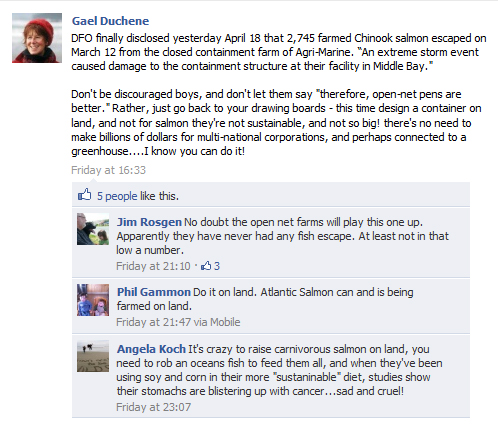
Even the fish farm protesters can't agree about growing salmon for profit.
(There were no escapes from net pens during the storm and there is no evidence of stomach cancer in B.C. farmed salmon.)
Is closed containment the answer to all the woes perceived by anti-fish farming activists? To put it bluntly, no. The truth is that even if the aquaculture industry moved on to land the anti-fish farm activists would still send up a hue and cry about the negative impacts that are worse when farming fish on land as opposed to in the ocean.
To have a land based system that matches the volume of fish currently harvested from farms in B.C. would require a huge amount of land that would be better suited to other uses. The anti-fish farm activists would complain about how much land is being used for industrial purposes. The energy requirements for the land based systems would be extensive and would require an energy source such as coal or hydro dams. One choice is bad for air quality and one choice destroys fish habitat. Neither are better for the wild salmon than what is happening right now. There is also very little if any profit to current closed containment technologies. Even the current “successful” projects have to rely on a second form of income, or generous grants from governments and philanthropic foundations, to stay open. Water based closed containment is expensive and the risk of escapes are very possible.

This is an example of land used for a fish farm hatchery by one of the major salmon farming companies. You can see the company's latest investment in closed-containment technology, a multi-million dollar RAS system, being constructed at the top of the photo. To raise salmon to full size at current volumes would require many times more land.
No one in the aquaculture industry is turning their back on closed containment. It is a vital part of the hatchery process and any improvements to the technologies benefit the industry.
The reality is that calling for the end to net-pen aquaculture is not the answer. Continued improvements in all the technologies related to aquaculture benefit the farms and the ocean.


 Is there finfish aquaculture in Alaska? Yes. Eggs are harvested from wild fish and grown in closed containment hatcheries. When they hatch they are fed commercial fish feed, then, when they are too big for closed containment facilities, they are put into ocean or lake net pens where they are fed pellets, leave their excrement on the ocean floor, deal with sea lice and receive vaccinations to ensure that the spread of disease is very low. However, because the fish are released into the ocean to return when they are mature, these operations are labeled “hatcheries” or “salmon enhancement programs” instead of fish farms.
Is there finfish aquaculture in Alaska? Yes. Eggs are harvested from wild fish and grown in closed containment hatcheries. When they hatch they are fed commercial fish feed, then, when they are too big for closed containment facilities, they are put into ocean or lake net pens where they are fed pellets, leave their excrement on the ocean floor, deal with sea lice and receive vaccinations to ensure that the spread of disease is very low. However, because the fish are released into the ocean to return when they are mature, these operations are labeled “hatcheries” or “salmon enhancement programs” instead of fish farms.

 As Juliet once said: “What’s in a name? That which we call a rose by any other name would smell as sweet.”
As Juliet once said: “What’s in a name? That which we call a rose by any other name would smell as sweet.”
 Marine Harvest Canada
Marine Harvest Canada Swift Aquaculture co-owner Bruce Swift farms a small amount of salmon in land-based closed-containment tanks in Agassiz and sells most of those fish to restaurants such as C, Nu and the Raincity Grill.
Swift Aquaculture co-owner Bruce Swift farms a small amount of salmon in land-based closed-containment tanks in Agassiz and sells most of those fish to restaurants such as C, Nu and the Raincity Grill.



 Canned fish comes from wild caught sources. Some frozen prepared fish (fish sticks etc.) come from wild sources, but fish like tilapia are farmed. Trout, Atlantic salmon and tilapia found in the fresh seafood section are farmed but most of the rest is wild. Most of the pacific salmon available in the grocery stores in Canada are caught in Alaska. Is farmed fish “bad?” Is Alaskan salmon really wild? How do we know for sure what the best choices are for the oceans?
Canned fish comes from wild caught sources. Some frozen prepared fish (fish sticks etc.) come from wild sources, but fish like tilapia are farmed. Trout, Atlantic salmon and tilapia found in the fresh seafood section are farmed but most of the rest is wild. Most of the pacific salmon available in the grocery stores in Canada are caught in Alaska. Is farmed fish “bad?” Is Alaskan salmon really wild? How do we know for sure what the best choices are for the oceans?
 MSC is based in London, England and only certifies fisheries, not farms. They have offices worldwide and seem to have a very thorough process.
MSC is based in London, England and only certifies fisheries, not farms. They have offices worldwide and seem to have a very thorough process.



